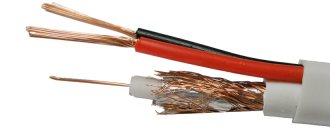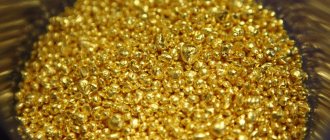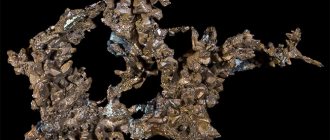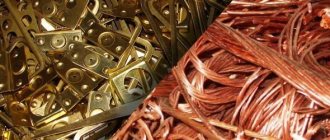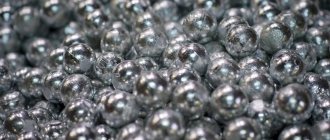Aluminum production
To produce aluminum, bauxite is used - a rock that contains aluminum oxide hydrates. The world's reserves of bauxite are almost unlimited and are incommensurate with the dynamics of demand.
Bauxite is crushed, ground and dried. The resulting mass is first heated with steam and then treated with alkali - most of the aluminum oxide passes into the alkaline solution. After this, the solution is stirred for a long time. At the electrolysis stage, alumina is exposed to an electric current of up to 400 kA. This allows the bond between the oxygen and aluminum atoms to be broken, leaving only liquid metal. The aluminum is then cast into ingots or various elements are added to it to create aluminum alloys.
Aluminum sheet grades
The production of sheet metal is regulated by GOST 21631-76. Sheets are produced from grades A0, A5, A6, A7, AD0, AD1 and alloys with magnesium, manganese, zinc. Aluminum has sufficient plasticity to solve a number of technological problems, but sometimes lacks mechanical characteristics. To improve quality, methods are used:
- Cladding: spraying of a metal layer; its thickness can be technological (B), normal (A), thickened (U);
- Cold forming: the orderly application of microdefects that form seals. According to the degree of processing, the sheets are cold-worked (H) and semi-hard-worked (H2);
- Heat-treated: hardening annealing and hardening are used.
Hardened semi-finished products are subjected to aging. After heating in the oven, the products are in a stationary state, at which time changes in the crystal lattice occur due to the precipitation of excess phase. Crystals saturated with alloying elements release individual atoms, which are concentrated at the grain boundaries. The particles formed in this way strengthen the alloy. Aging can be natural (at room temperature) or artificial (at a specially maintained temperature of up to 100-150 C⁰).
The processing performed is indicated as follows:
- M - annealed semi-finished products or those corresponding to them in mechanical parameters;
- T - hardened and naturally aged;
- T1 - hardened and artificially aged;
- TN - cold-hardened after hardening and natural aging.
The surface finish can be regular, elevated (P) and high (H). These letters are placed at the end of the marking; “P” indicated in the geometric parameters is 1000Px2000. means increased accuracy.
- A5 M 1.5x1000x2500 - annealed sheet 1.5 mm thick;
- AD1N 2.0x1200x3000 - cold-worked deformable;
- D16AT 5.0x1200x3000 - sheet of D16 duralumin with normal cladding (A), hardened and aged under natural conditions (T).
Rolled aluminum sheets are used in construction, the automotive industry, for the manufacture of stamped parts and the production of foil.
Aluminum alloys
The most common elements in aluminum alloys are copper, manganese, magnesium, zinc and silicon. Less common are alloys with titanium, beryllium, zirconium and lithium.
Aluminum alloys are conventionally divided into two groups: cast and wrought.
To make casting alloys, molten aluminum is poured into a mold that matches the configuration of the resulting product. These alloys often contain significant silicon impurities to improve castability.
Wrought alloys are first cast into ingots and then shaped into the desired shape.
This happens in several ways depending on the type of product:
- By rolling, if necessary, to obtain sheets and foil.
- By pressing, if you need to obtain profiles, pipes and rods.
- Molding to obtain complex shapes of semi-finished products.
- Forging, if you need to obtain complex shapes with increased mechanical properties.
Aluminum alloys
Terms and Definitions
Aluminum alloy – an aluminum-based alloy is aluminum that [1]:
- contains one or more alloying elements, as well as some impurities;
- aluminum predominates by mass over each of the other chemical elements;
- aluminum content does not exceed 99.00%.
An alloying element is a metallic or non-metallic element that is controlled within certain upper and lower limits for the purpose of imparting certain special properties to the aluminum alloy [1].
An impurity is a metallic or non-metallic element that is present in an alloy, the minimum content of which is not controlled. In aluminum alloys, as a rule, the maximum impurity concentration is controlled [1].
Alloying in aluminum alloys
The most important alloying elements that are used to transform aluminum into alloys with special properties - both wrought and castable (of course, in different quantities) - are:
The effect, for example, of copper content in an aluminum alloy on its mechanical properties is shown in Figure 1.
Figure 1 - Effect of alloying an aluminum alloy with copper on mechanical properties [3]
Iron in aluminum alloys
Wrought aluminum alloys contain approximately 0.1 – 0.4% (by weight) iron (Fe). Iron is generally viewed as an undesirable impurity. Its content depends on the quality of the original ore (bauxite) and the electrolytic reduction technology. Sometimes iron alloying is used to obtain special properties of a material, for example, to make aluminum foil.
Modification of alloys
Other alloying elements often used in combination with the main alloying elements are bismuth (Bi), boron (B), chromium (Cr), lead (Pb), nickel (Ni), titanium (Ti) and zirconium (Zr). These elements are usually used in small quantities (up to 0.1% by weight, although B, Pb and Cr can make up up to 0.5%) to give them special properties, modify alloys for special purposes such as castability, machinability, heat resistance, corrosion resistance, strength, etc.
Aluminum alloy grades
To mark aluminum alloys in accordance with GOST 4784-97, an alphanumeric system is used, in which:
- A - technical aluminum;
- D - duralumin;
- AK - aluminum alloy, malleable;
- AB - avial;
- B - high-strength aluminum alloy;
- AL - cast aluminum alloy;
- AMg - aluminum-magnesium alloy;
- AMts - aluminum-manganese alloy;
- SAP - sintered aluminum powders;
- SAS - sintered aluminum alloys.
After the first set of characters, the alloy grade number is indicated, and after the number is a letter that indicates its condition:
- M - alloy after annealing (soft);
- T - after hardening and natural aging;
- A - clad (a pure layer of aluminum is applied);
- N - hard-worked;
- P - semi-hardened.
Casting alloys
Aluminum-based casting alloys are generally marked with two letters. The second letter indicates the element from which the alloy is derived. For example, “ AK ” – aluminum-silicon system, “ AM ” – aluminum-copper, “ AMg ” – aluminum-magnesium, “ AMts ” – aluminum-manganese, etc. Then comes a number indicating the content of the element. If the alloy is alloyed, indicate the letter designations of the elements and their content:
For example, AK12M2 is an alloy of the aluminum-silicon system, with a silicon content of 12% (on average) and copper 2%. AMg4K is an aluminum-magnesium system containing 4% magnesium and 1% silicon.
If the cast aluminum alloy is thermally hardened, a heat treatment designation is placed at the end of the mark (GOST 1583-93):
T1 – artificial aging without pre-hardening;
T5 – hardening and short-term incomplete artificial aging;
T6 – hardening and complete artificial aging;
T7 – hardening and stabilizing tempering;
Marking based on the principle AL + numbers indicating the conventional brand number, for example AL9, is outdated, although it is still often found in technical documentation.
Source
Types and properties of aluminum alloys
Aluminum-magnesium alloys
These ductile alloys have good weldability, corrosion resistance and a high level of fatigue strength.
Aluminum-magnesium alloys contain up to 6% magnesium. The higher its content, the stronger the alloy. Each percent increase in magnesium concentration increases the tensile strength by approximately 30 MPa and the yield strength by approximately 20 MPa. Under such conditions, the relative elongation decreases, but only slightly, remaining within 30–35%. However, when the magnesium content exceeds 6%, the mechanical structure of the alloy in the cold-worked state becomes unstable, and corrosion resistance deteriorates.
To improve strength, chromium, manganese, titanium, silicon or vanadium are added to the alloys. Impurities of copper and iron, on the contrary, negatively affect alloys of this type - they reduce weldability and corrosion resistance.
Aluminum-manganese alloys
These are strong and ductile alloys that have a high level of corrosion resistance and good weldability.
To obtain a fine-grained structure, alloys of this type are alloyed with titanium, and manganese is added to maintain stability in the cold-worked state. The main impurities in Al-Mn alloys are iron and silicon.
Aluminum-copper-silicon alloys
Alloys of this type are also called alcusines. Due to their high technical properties, they are used in sleeve bearings, as well as in the manufacture of cylinder blocks. They have high surface hardness, so they are difficult to break in.
Aluminum-copper alloys
The mechanical properties of alloys of this type in a heat-strengthened state sometimes even exceed the mechanical properties of some low-carbon steels. Their main drawback is their low corrosion resistance, which is why these alloys are treated with surface protective coatings.
Aluminum-copper alloys are alloyed with manganese, silicon, iron and magnesium. The latter has the greatest influence on the properties of the alloy: alloying with magnesium significantly increases the yield strength and strength. Adding iron and nickel to the alloy increases its heat resistance, and silicon increases its ability to undergo artificial aging.
Aluminum-silicon alloys
Alloys of this type are otherwise called silumins. Some of them are modified with additions of sodium or lithium: the presence of literally 0.05% lithium or 0.1% sodium increases the silicon content in the eutectic alloy from 12% to 14%. The alloys are used for decorative casting, the manufacture of mechanism cases and elements of household appliances, since they have good casting properties.
Aluminum-zinc-magnesium alloys
Durable and well processed. A typical example of a high-strength alloy of this type is B95. This strength is explained by the high solubility of zinc and magnesium at a melting point of up to 70% and up to 17.4%, respectively. When cooled, the solubility of elements decreases noticeably.
The main disadvantage of these alloys - low corrosion resistance during mechanical stress - is corrected by alloying with copper.
Avial
Avial is a group of alloys of the aluminum-magnesium-silicon system with minor additions of other elements (Mn, Cr, Cu). The name is derived from the abbreviation of the phrase “aviation aluminum”.
Avial began to be used after the discovery by D. Hanson and M. Geiler of the effect of artificial aging and thermal hardening of this group of alloys due to the release of Mg2Si.
These alloys are characterized by high ductility and satisfactory corrosion resistance. Forged and stamped parts of complex shapes are made from aircraft. For example, spars of helicopter rotor blades. To improve corrosion resistance, the copper content is sometimes reduced to 0.1%.
The alloy is also actively used to replace stainless steel in mobile phone cases.
Aluminum grades
Editorial team E-metall Published 2021-03-13
Aluminum has an important place in the modern world. The metal, discovered only 1.5 centuries ago, is used for industrial, military and consumer purposes. Aluminum-based alloys are used for the manufacture of lightweight structures, as current conductors, food packaging, and finishing materials. The chemical element has good reducing properties and is used in metallurgy to deoxidize steel. Alloying with aluminum reduces the tendency to polymorphic decomposition in titanium alloys. Let's look at how aluminum is produced and how brand designations are deciphered.
One of the names: “silver from clay” indicates the smelting technology. In the natural environment, the metal does not occur in its pure form, as it has high chemical activity. Al₂O₃ oxide is the main component of alumina and is part of such natural minerals as ruby, sapphire, emerald, etc.
Due to the high affinity for oxygen, reduction with carbon, as in steel smelting, is impossible. Modern technology was developed in 1886 and consists of several stages:
- Bauxite (ore) production: Alumina is crushed, dried, and steamed to remove impurities;
- Dissolution of Al₂O₃ oxide in Na₃AIF₆ cryolite melt at 950 C⁰;
- Electrolysis of the melt in which the bond with oxygen is broken.
Various methods are used to remove impurities:
- Blowing with chlorine: reduces the content of non-metallic inclusions, iron, silicon, alkaline earth metals (Ca, Ba, Mg, Ra, Sr);
- Electrolytic refining: production of high purity aluminum (grade A995-A95);
- Precision methods: complex technologies for smelting metal of high purity 99.99%;
- Fractional crystallization: immersion in the melt of a heat exchanger that acts as a crystallizer or cooling of liquid metal using inert gases;
- Chemical methods based on the formation of intermetallic compounds, such as borides.
To impart additional properties, the alloy is alloyed with titanium, zinc, manganese, chromium, nickel and other elements. Depending on the content of pure metal, impurities and alloying elements, the composition is marked in accordance with GOST 4784-97.
Chemical composition of aluminum alloys
| Aluminum alloys | |||||||||||||
| Brand | Mass fraction of elements, % | Density, kg/dm³ | |||||||||||
| GOST | ISO209-1-89 | Silicon (Si) | Iron (Fe) | Copper (Cu) | Manganese (Mn) | Magnesium (Mg) | Chromium (Cr) | Zinc (Zn) | Titanium (Ti) | Other | Aluminum no less | ||
| Every | Sum | ||||||||||||
| AD000 | A199.8 1080A | 0,15 | 0,15 | 0,03 | 0,02 | 0,02 | 0,06 | 0,02 | 0,02 | 99,8 | 2,7 | ||
| AD00 1010 | A199.7 1070A | 0,2 | 0,25 | 0,03 | 0,03 | 0,03 | 0,07 | 0,03 | 0,03 | 99,7 | 2,7 | ||
| AD00E 1010E | EA199.7 1370 | 0,1 | 0,25 | 0,02 | 0,01 | 0,02 | 0,01 | 0,04 | Boron:0.02 Vanadium+titanium:0.02 | 0,1 | 99,7 | 2,7 | |
What are the different grades of aluminum?
Giving a metal certain properties and enhancing its characteristics is possible by alloying it with various chemical elements, such as magnesium, copper, zinc, silicon, and manganese.
There are different grades of aluminum that meet certain standards, for example, “AD0” according to GOST 4784-97. To avoid confusion, the classification includes high-frequency metals.
Aluminum can be of the following grades:
- Primary (“A5”, “A95”, “A7E”).
- Technical (“AD1”, “AD000”, “ADS”).
- Deformable (“AMg2”, “D1”).
- Foundry (“VAL10M”, “AK12pch”).
- For deoxidation of steel (“AV86”, “AV97F”).
In addition to the listed grades of aluminum, its compounds are distinguished separately, with the help of which they create alloys with gold, silver, platinum, and other precious metals. Such compounds are called ligatures.
Application of aluminum
Jewelry
In the distant past, due to the high cost of aluminum, it was used to make jewelry. Thus, scales with aluminum and gold bowls were presented to D. I. Mendeleev in 1889.
When the cost of aluminum decreased, the fashion for jewelry made from this metal passed away. But even today it is used to make jewelry. In Japan, for example, aluminum is used to replace silver in the production of national jewelry.
Cutlery
Aluminum cutlery and cookware continue to be popular. In particular, aluminum flasks, pots and spoons are widely used in the army.
Glass making
Aluminum is widely used in glass making. High reflectivity and low cost of vacuum deposition are the main reasons for using aluminum in the manufacture of mirrors.
Food industry
Aluminum is registered as a food additive E173. It is used as a food coloring and also to preserve food from mold. E173 colors confectionery products in a silver color.
Military industry
Due to its light weight and low cost, aluminum is widely used in the manufacture of small arms - machine guns and pistols.
Rocketry
Aluminum and its compounds are used as rocket fuel in two-component rocket propellants and as a combustible component in solid rocket propellants.
Aluminum energy
In the aluminum energy industry, aluminum is used to produce hydrogen and thermal energy, as well as to generate electricity in air-aluminum electrochemical generators.
Areas of application
Aluminum and aluminum alloys are widely used due to their basic performance characteristics. Their use largely depends on the composition. Let's take the following points as an example:
- Initially, alloys began to be used in the manufacture of elements of airships or aircraft, which is associated with lightness and strength.
- Today, due to the fact that the composition determines melting at fairly high temperatures, alloys have begun to be used in the manufacture of high-speed trains. Aluminum alloys are used to reduce their weight. When moving at high speed, the surface heats up, but does not deform.
- Mechanical engineering, food and light industries, the production of household appliances and electronics - the use of aluminum alloy is very extensive.
Rolled aluminum
Such a wide scope of application is also determined by the fact that the alloy production process is very simple, the resulting material does not have a high cost, and the performance qualities can be changed by adding various alloying elements.
Grades of food grade aluminum according to GOST
Do you have a large amount of old aluminum scrap accumulated at home and you don’t know what to do with it? The best option would be to recycle it at a non-ferrous metals collection point. At our VtorBaza collection points you can hand over collected scrap at a competitive price. We accept different grades of food-grade aluminum according to GOST in any unlimited quantity. Leave a request on our website at any convenient time. To determine the requirements for aluminum in contact with food, we have provided you with tables.
Buy, price from Auremo
sells products made of aluminum and its alloys, the price is optimal. We supply pipes made of aluminum alloys in metric and inch sizes. The catalog provides a wide selection of products. The price depends on the order volume and additional delivery conditions. Wholesale customers receive preferential prices. Experienced managers are in touch and will quickly help you buy the necessary products. And a large assortment will not leave you without choice. We have the best price-quality ratio. Buy aluminum today. We invite you to partner cooperation. Buy today. The best price from the supplier.
Use of aluminum for food packaging
Foil and special forms are produced from sheet material, which are increasingly used and used in the form of packaging. This allows you to maintain the temperature and excellent taste of dishes, as well as reheat or freeze them without losing quality or beautiful appearance.
The metal is harmless to health and does not adversely affect the properties of dishes. Aluminum packaging, which can take on and retain any shape, is used for transporting semi-finished products, fast food, meat and fish, as well as other products.
Primary aluminum
Primary aluminum (grade A5) is a typical example of this group. It is obtained by enriching alumina. The metal is not found in nature in its pure form due to its high chemical activity. Combining with other elements, it forms bauxite, nepheline and alunite. Subsequently, alumina is obtained from these ores, and from it, using complex chemical and physical processes, pure aluminum is obtained.
GOST 11069 establishes requirements for grades of primary aluminum, which should be marked by applying vertical and horizontal stripes with indelible paint of various colors. This material has found wide application in advanced industries, mainly where high technical characteristics are required from raw materials.
The use of aluminum alloys in products in contact with food
This metal is used to produce a variety of dishes, meat grinders, containers for storing liquids and mixtures, cutlery, machines for workshops and conveyors for moving products, various types of accessories and other products.
The raw materials are also used for the production of heat-resistant surfaces and a variety of kitchen equipment. Dishes made from such alloys do not change the properties of food products, they retain the beneficial substances present in them, as well as the original properties and microelements important for the body.
Cast aluminum
Aluminum foundry grades are used for the production of shaped products. Their main feature is the combination of high specific strength and low density, which makes it possible to cast products of complex shapes without cracking.
According to their purpose, foundry grades are conventionally divided into groups:
- Highly hermetic materials (AL2, AL9, AL4M).
- Materials with high strength and heat resistance (AL 19, AL5, AL33).
- Substances with high anti-corrosion resistance.
Very often, the performance characteristics of cast aluminum products are increased by various types of heat treatment.
GOST food grade aluminum and grades
All brands of raw materials used, permitted for use, are strictly specified in GOST. Each of them has its own chemical composition. Various alloys listed below can come into contact with products.
Grades of food grade aluminum (basic requirements)
In accordance with GOST 1583-93
Aluminum casting alloys:
- clause 3.3
For the manufacture of food products, alloys AK7, AK5M2, AK9, AK12 are used. The use of other grades of alloys for the manufacture of products and equipment intended for contact with food products and environments must be permitted by health authorities in each individual case. Also on this matter, see the next section below: Brands of food-grade aluminum for dishes and cutlery. In aluminum alloys intended for the manufacture of food products, the mass fraction of lead should be no more than 0.15%, arsenic - no more than 0.015%, zinc - no more than 0.3%, beryllium - no more than 0.0005%. - clause 4.1.6.1
Ingots intended for the manufacture of products and equipment in contact with food products are marked, in the absence of color markings, with an additional letter “P”, which is placed after the designation of the alloy grade.
In accordance with GOST 4784-97
Aluminum and wrought aluminum alloys:
- clause 3.4.1
In the AMg2 alloy intended for the manufacture of tape used as packaging containers in the food industry, the mass fraction of magnesium should be from 1.8 to 3.2%. - clause 3.8
In aluminum and aluminum alloys, semi-finished products from which are used in the manufacture of food products, the mass fraction of lead should be no more than 0.15%, the mass fraction of arsenic should be no more than 0.015%. Grades of aluminum and aluminum alloys for food use are additionally marked with the letter “Ш”.
Grades of food-grade aluminum for dishes and cutlery (table with GOST standards)
Grades of food-grade aluminum for cookware regulated by GOST 17151-2019 Household cookware made of sheet aluminum. Valid from 01.11.2019, replacing the old GOST 17151–81
| Manufactured product | Acceptable grades of aluminum | Regulatory document |
| Dishes | A7, A6, A5, A0 | GOST 11069 |
| Sheets and tapes AD1, AD | GOST 4784 | |
| Bimetallic aluminum tapes AD1, AD | ||
| If the cookware has an internal coating, it is allowed to make it from sheets and strips of aluminum alloy AMts | ||
| Fastening parts for cookware that come into contact with food | The requirements are the same as for dishes (lines above) | |
| Utensil fittings (handles, arms and ears) | Sheets and tapes used for the manufacture of reinforcement must be cold-worked | GOST 4784 and GOST 11069 |
| The interior surface of the cookware must be etched, brushed, ground, enamelled, stainless steel clad, anodic oxide coated, or non-stick (non-stick) coated. | ||
Grades of food-grade aluminum for cutlery, regulated GOST 51016–97 Cutlery made of carbon steel and aluminum alloys
| Manufactured product | Acceptable grades of aluminum | Regulatory document |
| All-metal forks and the working part of combined forks | A0, AVM, AD1M | GOST 21631 |
| AD1, AB, AMg2 | GOST 4784 | |
| AK7, AK5M2, AL22, AL23 | GOST 1583 | |
| Spoons | A0, AVM, AD1M, AD1, AB | GOST 21631 |
| AMg2 | GOST 4784 | |
| AK7, AK5M2, AL22, AL23 | GOST 1583 | |
| Handles of combination knives and forks | A0, AVM, AD1M | GOST 21631 |
| Fittings for combined products (rings, caps, washers, rivets) | AD1 | GOST 4784 |
Provider
The supplier Auremo offers to buy aluminum in bulk or in installments. Large selection of semi-finished products in stock. Optimal price of aluminum from the supplier "Auremo". All batches of products have a quality certificate for compliance with standards and technical operating conditions. The certificate indicates the manufacturer, drawing number, alloy grade, chemical composition, mechanical properties and the results of additional tests, for example, hydrotests or pneumatic tests. Implementation of orders in the shortest possible time. Buy aluminum from special warehouses of the supplier Auremo. Wholesale customers receive discounts. Buy aluminum today.
Is this aluminum accepted for scrap and at what price?
The raw material is not the most expensive type of aluminum scrap, but not the cheapest either. Food-grade aluminum in Moscow is accepted for scrap metal at different prices per 1 kilogram. Ours sets the following cost per kilogram for the following types of scrap:
- Aluminum cans - 30-51 rubles;
- Foil - 45-76 rubles;
- Aluminum containers and utensils - 60-93 rubles.
The final cost of such products is influenced by:
- the degree of purity of the alloy and the presence of impurities present in it;
- volume of collected delivery lot;
- quality and characteristics of the alloy.
The scrap is melted down and reused to make kitchen items, accessories and equipment.
Chemical composition and certification of food grade aluminum
Food grade metal Al is produced in accordance with the current regulations and standards of GOST 1583-93, and its composition contains no more than 0.15% lead. The presence of zinc in the alloy of this metal does not exceed 0.3%, and the arsenic content is no more than 0.015%. The beryllium content does not exceed 0.0005%.
Products that come into direct contact with food are subject to mandatory certification. These are cutlery, jars and special foil used for packaging purposes. Such products require mandatory receipt of a hygiene certificate.
Advantages and disadvantages of aluminum cookware
Crockery and cutlery made from this material are present in any modern kitchen. Main advantages of kitchen items:
- good thermal conductivity – pots and pans heat up faster;
- uniform heating of prepared dishes;
- light weight of various kitchen accessories;
- absolute harmlessness to food due to the formation of a special oxide film on their surface;
- Convenient placement of items on shelves in the kitchen.
You can talk about the dangers of dishes made of this metal if they are used incorrectly. For example, if there is no non-stick coating, you cannot cook acidic dishes in it, as this leads to the release of metal into the dishes and to poisoning. See the video below for other shortcomings.
Brands of technical aluminum
In grades of technical (unalloyed) aluminum, the content of foreign impurities is no more than 1%.
According to GOST 4784-97, grades of technical aluminum must have increased anti-corrosion resistance. However, their strength is not very high. The absence of alloying elements in the metal leads to the formation of a stable protective oxide film on its surface.
Distinctive features of grades of technical aluminum are high thermal and electrical conductivity. The molecular lattice is distinguished by the almost complete absence of impurities that scatter the flow of electrons. Such properties allow the metal to be used in such areas as instrument making, the manufacture of equipment for heating and heat transfer, and lighting.
Marking of aluminum alloys
There is no single digital marking of aluminum alloys; wrought, cast and sintered alloys are marked differently.
Deformable alloys have letter and alphanumeric markings, and the choice of letters and numbers is made randomly: the Al-Si-Cu-Mg alloy is designated AB (avial), the Al-Mn alloy is designated AMts, and the AL-Mg alloy is designated -AMg. The numbers following the letters approximately correspond to the content of the alloying element. For a group of alloys, the first numbers after the letters indicate, respectively: 1-alloys, hardened by Cu and Mg (D16); 2-alloys hardened by Cu, Mn, or Cu, Mn, Cd, Li (D20); 3- alloys hardened with Mg and Si (AD31); 4- alloys hardened with Zn and Mg or Zn, Mg and Cu (B95), etc. Forging alloys are marked with the letters AK (AK6, AK8), and duralumin – with the letter D. Powder alloys are marked with the letters SAP (sintered aluminum powder) or SAS (sintered aluminum alloy). The number after the letters is the serial number.
Casting alloys are marked with letters and numbers: the letter indicates the presence of an alloying element, and the number after the letter is the average content of the element in %. (K-silicon, M-copper, Mn-manganese, Mg-magnesium, N-nickel, C-zinc) For example, AK12M2 - 12% silicon, 2% copper, the rest is aluminum.
Characteristics and classification of aluminum alloys.
To increase mechanical properties (strength, ductility, etc.), improve technological properties (heat resistance, machinability, corrosion resistance, etc.), aluminum is alloyed with Si, Cu, Mg, Zn and, less commonly, Li, Ni, Be, Zr. Most alloying elements form solid solutions of limited solubility with aluminum and intermediate phases with aluminum (CuAl, CuMgAl, etc.).
Aluminum alloys according to manufacturing technology are divided into three groups: wrought (GOST 4784-97), cast (GOST 2583-93), sintered.
Based on their ability to heat treatment, they are divided into those that can be strengthened and those that cannot be strengthened by heat treatment, which is due to the presence of strengthening phases that have limited solubility in aluminum.
According to their properties, alloys are divided into alloys with increased ductility, normal and high strength, corrosion-resistant and heat-resistant.
Deformable aluminum alloys that cannot be strengthened by heat treatment.
This group of alloys includes alloys of aluminum with manganese AMts and magnesium AMg. The alloys are characterized by low strength (σb = 110 MPa), high ductility (δ = 30%), which ensures good workability under pressure, good weldability and high corrosion resistance. Cutting is difficult.
AMts and AMg alloys are used for welded and riveted structural elements that experience light loads but require high corrosion resistance.
The use of wrought alloys that cannot be strengthened by heat treatment.
| No. | Brand | Purpose |
| 1. | AMts | Parts made by rough drawing and welding: tanks, rivets, gas lines, oil lines, radiators of cars, tractors, etc. |
| 2. | AMts1 | The alloy is used in the electrical industry: electric tachometer sensors, etc. |
| 3. | AMg1 AMg 6 | Lightly loaded parts: mirrors, pipelines, containers for liquids (canisters, tanks); parts requiring deep drawing, bending: hulls of sea and river vessels, subway cars, buildings (window frames, doors, heat exchanger coils, radiators, etc.) |
These alloys are marked with letters and numbers: A-aluminum alloy, Mts-manganese, Mg-magnesium. The AMts alloy contains 1.0-1.6% Mn and about 1% other impurities (Fe, Si, Cu, etc.). The AMts1 alloy contains 2-4.6 MP, the rest is aluminum. In AMg alloys, the number indicates the average manganese content (AMg1 Mn=0.4-1.7%, AMg6 Mn=5.8-6.8%).
Deformable aluminum alloys, hardened by heat treatment.
These alloys are divided into alloys of normal strength - duralumin (D1, D3, D16), high-strength alloys (V95, V96, VAD23), heat-resistant alloys (AK4, D20, D21), alloys for forging and stamping (AK6, AK8).
Duralumins.
Duralumins are alloys of the Al-Cu-Mg-Mn system. A typical representative of duralumin is the D1 alloy (Cu=4%, Mn=0.5%, Mg=0.5%, the rest is Al). It is used after hardening (T=500 o C, cooling in water with T=40 o C) and artificial aging (T=195 o C, exposure-12 hours) or natural (T=20 o C, exposure-96 hours), while D1 has the following properties: σb=540 MPa, δ=11%.
Duralumins have reduced corrosion resistance in river and sea water, as well as in humid air, therefore, to protect them from corrosion, they are subjected to cladding, that is, coating with a thin layer (5% of the sheet thickness) of high purity aluminum (A5-A7) or anodizing to create oxide film. Duralumins are produced in the form of sheets, pipes, pressed and rolled profiles, and wire for rivets.
| No. | Brand | Purpose |
| 1. | D 1 | Medium strength parts, stamped assemblies, fasteners, rivets, propeller blades, etc. |
| 2. | D16 | Load-bearing heavily loaded parts: frames, stringers, aircraft spars, load-bearing frames, building structures, truck bodies, beams, cabin trim, etc. |
| 3. | D18 D19P | Rivets. |
High strength alloys.
High strength is achieved by introducing Zn into Al-Cu-Mg-Mn systems. The tensile strength of such alloys reaches 600-700 MPa with ductility δ = 8-12% (less than that of duralumin). A typical representative of high-strength alloys is B95 (Cu=1.8%, Mg=2%, Mn=0.4%, Zn=6%). The alloys are used after hardening (T = 470 o C, cooling - water 20-30 o C) and artificial aging ( T = 120 o C, holding for 24 hours), while B95 has the following properties: σb = 600 MPa, δ = 12 %. Disadvantages of alloys include a tendency to stress corrosion and sensitivity to stress concentrators. The alloys have good ductility in a hot state, are easily deformed in a cold state after annealing, and are well processed by cutting. They are used in the form of sheets, plates, panels, stampings, as well as pressed profiles. These alloys have the highest strength of all known aluminum alloys. Table 6.3
Use of high-strength alloys.
| No. | Brand | Purpose |
| 1. | B95 | Highly loaded structural parts operating under compression conditions: aircraft skin, stringers, frames, spars. |
| 2. | V93P | Large-sized and complex stampings for critical purposes. |
Heat-resistant alloys.
These are alloys that operate at temperatures up to 300 o C. (AK 4, D20, D21). They are based on the Al-Cu-Mg system, have a complex composition and are additionally alloyed with Fe, Ni and Cu, which form strengthening phases that are less prone to coagulation at elevated temperatures. A typical heat-resistant alloy is AK4: (Cu=2%, Mg=1.5%, Fe=1%, Si=1%). Heat-resistant alloys are used after hardening (T = 530 o C, cooling in boiling water) and artificial aging (T = 170 o C, holding for 16 hours), while the AK4 alloy has the following properties: σb = 440 MPa, δ = 7 %. The alloys are well processed by cutting, welded by spot and roller welding, have satisfactory corrosion resistance, low coefficient of friction, and high wear resistance, therefore they are widely used in aircraft, automobile, and tractor construction in the form of forgings, stampings of sheets, plates, and extruded profiles.
Classification of aluminum grades
Primary aluminum is produced according to GOST 11069-2001 or GOST R 55375-2012. The purity index determines the physical and chemical properties for which the use of metal is justified in certain industries.
- Special: 99.999% - designation A999. For semiconductor manufacturing and laboratory work;
- High: 99.95 -99.995% - brands A95, A97, A99, A995. Production of radio and electrical equipment parts;
- Technical: 99-99.85% - A0, A5, A6, A7, A8, A85. For wires, gaskets and preparation of alloys.
Brand designations reflect only hundredths of a percent of pure metal content, since it is always above 99%. Technical aluminum is used for various purposes, including for the manufacture of packaging and tableware. The following terms are used to describe qualities:
- Primary: according to the degree of purification P, OCH, PCh (pure, special purity and increased);
- Technical: all raw materials with impurity content from 0.15 to 1%;
- Deformable (AD): intended for the production of semi-finished products using rolling technology;
- Foundry: for the production of products by casting method;
- For steel deoxidation: low purity consumables.
Deformable aluminum is designated by the abbreviation AD, for example: AD000, AD00. The letter E expresses the specified electrical characteristics, AD1pl is a material intended for cladding thin-sheet rolled products. Along with these markings, digital markings are used: AD0 corresponds to 1011, AD1 to 1013.
Table of main grades of aluminum and alloys
| Primary aluminum | |||||
| A0 | A5 | A5E | A6 | A7 | |
| A7E | A8 | A85 | A95 | A97 | |
| A99 | A995 | A999 | |||
| Technical aluminum | |||||
| HELL | AD0 | AD00 | AD000 | AD00E | |
| AD0E | AD1 | ADoch | ADS | ADH | |
| Aluminum for deoxidation | |||||
| AB86 | AV86F | AB88 | AV88F | AB91 | |
| AV91F | AB92 | AV92F | AB97 | AV97F | |
| Cast aluminum | |||||
| AK21M2.5N2.5 | AK4M4 | AK5M2 | AK5M7 | AK7 | |
| AK7M2 | AK9 | AL1 | AL11 | AL13 | |
| AL19 | AL2 | AL21 | AL22 | AL23 | |
| AL23-1 | AL24 | AL25 | AL26 | AL27 | |
| AL27-1 | AL28 | AL29 | AL3 | AL30 | |
| AL32 | AL33 | AL34 | AL4 | AL4-1 | |
| AL4M | AL5 | AL5-1 | AL6 | AL7 | |
| AL7-4 | AL8 | AL9 | AL9-1 | B124 | |
| B2616 | VAL10 | VAL10M | VAL11 | VAL12 | |
| VAL8 | |||||
| Aluminum wrought alloy | |||||
| 1201 | 1420 | AB | AD31 | AD33 | |
| AD35 | AK4 | AK4-1 | AK6 | AK8 | |
| AMg1 | AMg2 | AMg3 | AMg3S | AMg4 | |
| AMg4.5 | AMg5 | AMg5P | AMg6 | AMts | |
| AMtsS | ATspl | B65 | B93 | B94 | |
| B95 | V95P | B96 | V96ts | V96TS1 | |
| VD17 | D1 | D12 | D16 | D16P | |
| D18 | D19 | D1P | D20 | D21 | |
| MM | |||||
| Aluminum anti-friction alloy | |||||
| AMST | AN-2.52 | AO20-1 | AO3-12 | AO3-7 | |
| AO6-1 | AO9-1 | AO9-2 | AO9-2B | AFM | |
Notation standards
GOST 4784 “Aluminum and wrought aluminum alloys. Marki" provides marking of alloys in three ways: according to this document itself, both in alphanumeric form and only in digital form, as well as taking into account the requirements of the international standard (international marking) ISO 209-1 (ISO 209-1 Wrought aluminum and aluminum alloys — Chemical composition and forms of products — Part 1: Chemical composition ).
Triple marking of aluminum alloys does not allow replacing the alloy, which is indicated in the documentation in alphanumeric form according to GOST, with a completely similar material with international marking. The problem is not only bureaucratic procedures or non-compliance of the chemical composition with the requirements of the standard. Mechanical and technological properties depend both on the brand of aluminum alloy and thermomechanical processing modes, as well as on the technology of such processing of a particular manufacturer of semi-finished products.
Wrought aluminum
Deformable aluminum includes a material that is subjected to hot and cold pressure treatment: rolling, pressing, drawing and other types. As a result of plastic deformations, semi-finished products of various longitudinal sections are obtained from it: aluminum rod, sheet, strip, plate, profiles and others.
The main grades of deformable material used in domestic production are given in the regulatory documents: GOST 4784, OCT1 92014-90, OCT1 90048 and OCT1 90026. A characteristic feature of deformable raw materials is the solid structure of the solution with a high content of eutectic - the liquid phase, which is in equilibrium with two or more solid states of matter.
The scope of application of deformable aluminum, like that where aluminum rod is used, is quite extensive. It is used both in areas requiring high technical characteristics of materials - in ship and aircraft construction, and on construction sites as an alloy for welding.
Digital marking according to GOST means from left → right:
- first digit - base metal 1-aluminum
- second digit - alloying system
- third and fourth digits - brand and modification
| Brand according to GOST | Group of alloys, main alloying system |
| 1000–1018 | Technical aluminum |
| 1019, 1029, etc. | Powder alloys |
| 1020–1025 | Foamed aluminum |
| 1100–1190 | Al—Cu—Mg, Al—Cu—Mg—Fe—Ni |
| 1200–1290 | Al—Cu—Mn, Al—Cu—Li—Mn—Cd |
| 1300–1390 | Al—Mg—Si, Al—Mg—Si—Cu |
| 1319, 1329, etc. | Al—Si, powder alloys SAS |
| 1400–1419 | Al—Mn, Al—Be—Mg |
| 1420–1490 | Al—Li |
| 1500–1590 | Al—Mg |
| 1900–1990 | Al—Zn—Mg, Al—Zn—Mg—Cu |
Important ! Digital marking according to GOST does not coincide with the international marking of aluminum alloys

